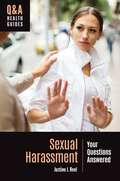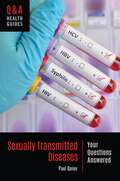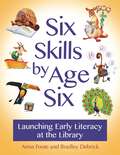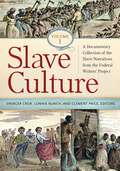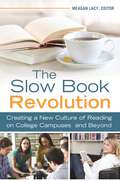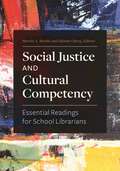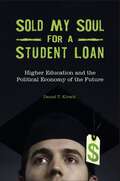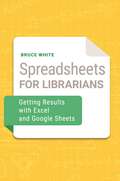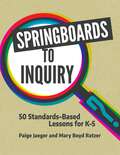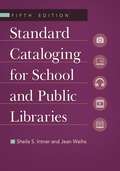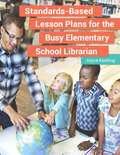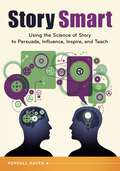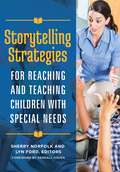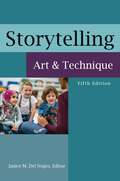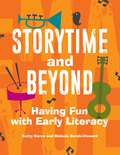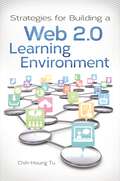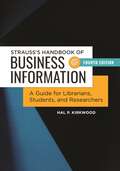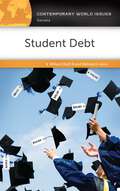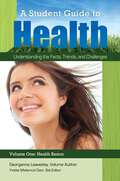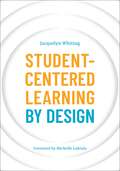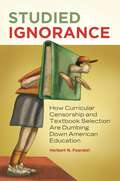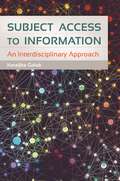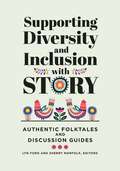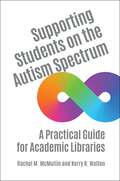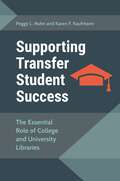- Table View
- List View
Sexual Harassment: Your Questions Answered (Q&A Health Guides)
by Justine J. ReelThis book answers readers' most pressing questions about sexual harassment, including how to identify it, its causes, and its effects. It also provides guidance and resources for anyone experiencing or witnessing sexual harassment.Unfortunately, sexual harassment is an all-too-common reality for many women and men. But what exactly constitutes sexual harassment, and how is it different from assault, bullying, and other forms of unwanted attention? Why is sexual harassment so common? How can being sexually harassed impact an individual's academic or work performance, psychological well-being, and even physical health? What can you do if you experience sexual harassment or believe someone else is experiencing it?Books in Greenwood's Q&A Health Guides series follow a reader-friendly question-and-answer format that anticipates readers' needs and concerns. Prevalent myths and misconceptions are identified and dispelled, and a collection of case studies illustrates key concepts and issues through relatable stories and insightful recommendations. Each book also includes a section on health literacy, equipping teens and young adults with practical tools and strategies for finding, evaluating, and using credible sources of health information both on and off the internet—important skills that contribute to a lifetime of healthy decision-making.
Sexually Transmitted Diseases: Your Questions Answered (Q&A Health Guides)
by Paul QuinnThis valuable book provides a delicate introduction to the topic of sexually transmitted diseases (STDs), especially as they relate to teens and young adults.Sexually transmitted diseases (STDs) are on the rise globally, despite advances in science, technology, and the pharmaceutical industry. Individuals may not realize they have an STD or may be reluctant to get tested or seek treatment because of the stigma surrounding such conditions. This title in Greenwood's Q&A Health Guides series, Sexually Transmitted Diseases: Your Questions Answered provides clear, concise information for readers who want to learn more about and safeguard their sexual health. In addition to in-depth discussion of all STDs, it covers topics such as prevention, testing, disclosure with partners, and potential long-term consequences.Each book in this series follows a reader-friendly question-and-answer format that anticipates readers' needs and concerns. Prevalent myths and misconceptions are identified and dispelled, and a collection of case studies illustrates key concepts and issues through relatable stories and insightful recommendations. The book also includes a section on health literacy, equipping teens and young adults with practical tools and strategies for finding, evaluating, and using credible sources of health information both on and off the internet—important skills that contribute to a lifetime of healthy decision-making.
Six Skills by Age Six: Launching Early Literacy at the Library
by Anna Foote Bradley DebrickThis one-stop guide to nurturing six core early literacy skills at your library also offers practical tips for sharing these skills with parents, teachers, and other caregivers so they can institute them in playgroups, in school, or at home.Though libraries have been presenting early literacy activities for decades, library staff may lack an in-depth understanding of early literacy skills and their place in preparing children for a lifetime of learning. Based on the program "6 by 6: Ready to Read," this book is chock full of practical, everyday ideas on how you can foster the six core early literacy skills children should ideally acquire by age six. The volume begins by introducing the importance of early literacy and explaining how to start or expand an early literacy program in your library, regardless of its size. Subsequent chapters explore the six core skills and offer suggestions on how to showcase them in library programs and services. The book also includes activities that relate to each skill, suggests books that are especially useful in exploring each skill, and tells you how to create early literacy spaces. Three sets of storytime plans—one each for babies, toddlers, and preschoolers—are presented as well. Written primarily for public librarians and library staff, this guide will also be informative for parents and for educators who work with young girls and boys.
Slave Culture [3 volumes]: A Documentary Collection of the Slave Narratives from the Federal Writers' Project [3 volumes]
by Spencer Crew Lonnie Bunch Clement PriceFor the first time, the WPA Slave Narratives are organized by theme, making it easier to examine—and understand—specific aspects of slave life and culture.There is no better way to appreciate history than to experience it through the eyes of those who lived it. Slave Culture: A Documentary Collection of the Slave Narratives from the Federal Writers' Project brings together the memories of the last generation of enslaved African Americans gathered through interviews conducted between 1936 and 1938. This three-volume work stands apart from previous Slave Narrative collections in that it organizes the narratives thematically, bringing the rich tapestry of slave culture to life in a fresh way. Within each thematic area, multiple excerpts span time, gender, and geography. An introductory essay for each theme and a contextual explanation for each narrative help readers draw lessons from this vast collection, while an introduction to the work explains the Works Progress Administration's Slave Narrative project—illuminating still another era in American history.
The Slow Book Revolution: Creating a New Culture of Reading on College Campuses and Beyond
by Meagan LacyThis inspiring guide shows how to implement the principles of the Slow Book movement in college campus libraries as well as public and high school libraries, with the ultimate goals of encouraging pensive reading habits and creating a lifelong enjoyment of books.In a world of constant Facebook posts and Tweets, digital distractions and online reading habits are wearing at students' ability to focus, reflect, synthesize, and think deeply. This professional text, based on a concept introduced by Maura Kelly in the online edition of The Atlantic, delves into the trend toward contemplative reading—otherwise known as the Slow Book movement—explaining what it is, why it's important, and how you can implement it in various ways and in multiple settings.Author and librarian Meagan Lacy, along with contributions from others in the field, offers insights, advice, and practical tools to help you foster an appreciation of reading in students both during and after college. The first part of the book establishes the importance of the Slow Book movement, while the second and third sections combine case studies and guidance for employing the principles of this method across multiple genres, including fiction, nonfiction, classics, and contemporary works. Chapters build a rationale for the approach, describe its underlying philosophy, and articulate concrete ways to apply the methodology in different venues.
Social Justice and Cultural Competency: Essential Readings for School Librarians
by Marcia A. Mardis and Dianne Oberg, EditorsPublished in partnership with the International Association of School Librarianship, this work gathers together the latest and most important research on the topics of social justice and cultural competency in school libraries.Education systems today are expected to advance national goals related to fairness, equity, and social cohesion. Comprising articles written and collected in the journal of the International Association of School Librarianship and new articles written especially for this anthology, this book documents both empirical research and promising practices to help school librarians and teachers work together to promote social justice and develop learners' and educators' cultural competence.Both coeditors are experienced in working with authors from around the world and have participated in the development of effective and ethical standards and guidelines for school library practitioners. Brief real-life case studies of school librarians and teachers in action showcase efforts to improve the lives of marginalized or under-served students. School librarians inside and outside of the United States, school library educators and policymakers, and academic librarians building school librarianship collections will find this guide valuable.
Sold My Soul for a Student Loan: Higher Education and the Political Economy of the Future
by Daniel T. KirschWith unprecedented student debt keeping an entire generation from realizing the "American Dream," this book sounds a warning about how that debt may undermine both higher education—and our democracy.American higher education boasts one of the most impressive legacies in the world, but the price of admission for many is now endless debt. As this book shows, increasing educational indebtedness undermines the real value of higher education in our democracy. To help readers understand this dilemma, the book examines how student debt became commonplace and what the long-term effects of such an ongoing reality might be. Sold My Soul for a Student Loan examines this vitally important issue from an unprecedented diversity of perspectives, focusing on the fact that student debt is hindering the ability of millions of people to enter the job market, the housing market, the consumer economy, and the political process.Among other topics, the book covers the history of consumer debt in the United States, the history of federal policy toward higher education, and political action in response to the issue of student debt. Perhaps most importantly, it explores the new relationship debtor-citizens have to the government as a result of debt, and how that impacts democracy for a new generation.
Spreadsheets for Librarians: Getting Results with Excel and Google Sheets
by Bruce WhiteWork smarter and save time with the librarian's guide to the hidden-in-plain-sight secrets of Excel, Sheets, and other types of spreadsheets.While some librarians have become very skilled at using the full power of Excel and Sheets to turn data into useful and valuable information, for many librarians the relevance of spreadsheets—and how to use them—is not necessarily obvious.This book demystifies Excel and other spreadsheets. Starting from basic concepts, the book progresses to advanced implementations important to librarians in such areas as collection management, including evaluation and benchmarking; research assessment through the creation of sophisticated bibliometric measures; and library design based on an analysis of patron behavior or the creation of a keyword map of physical collections. Real-life examples highlight a variety of techniques and shortcuts that can be immediately applied to libraries of all kinds.Spreadsheets for Librarians is a book for the desk, not only the library shelves. No prior knowledge of spreadsheets is needed, and readers can expect to learn skills that will enhance their reputation as information and data professionals.
Springboards to Inquiry: 50 Standards-Based Lessons for K-5
by Paige Jaeger Mary Boyd RatzerThis collection of ideas for lessons provides school librarians with inspiration for meeting the tsunami of new standards dictating change for today's next generation learners.Today's school librarian has less and less time to prepare for instruction. This book delivers lesson plans for the librarian to implement immediately, as is or with a little adaptation. Using the new AASL standards and an Information Literacy scope and sequence carefully crafted for K–6 students, the authors package lessons that are both engaging and challenging.This book inspires librarians to go beyond their usual role in literacy promotion and instruction only and moves to preparing students to be inquiry learners by embracing inquiry-based learning. Lessons include the Essential Question (begin with the end in mind); pre- and post-assessment ideas; technology integration ideas, where applicable; reading and research ideas; and collaboration ideas when applicable. AASL Standards and others are noted via an "integrated standards checklist," while new educational research demonstrates that standards can be met via engaging, collaborative, and interesting lessons, modeled throughout the text.
Standard Cataloging for School and Public Libraries
by Sheila S. Intner Jean WeihsA proven resource for librarians and students, this updated classic opens the door to understanding current library cataloging processes, shows you how to use them to create standard catalog records, and provides guidance in managing the cataloging workflow.Library cataloging and classification tools are constantly improving, making this concise guide a necessity for any librarian or library student seeking improved understanding of the practical process of cataloging today. With the release of RDA, a new code for description, and a new edition of Dewey Classification, it's time for every library to add this fifth edition of a classic reference to your resources. Two Margaret Mann Citation winners update you on the five basic steps in standardized library cataloging: describing and adding access points for resources; assigning subject headings using Sears List or Library of Congress subject headings; classifying them using the Dewey Decimal or Library of Congress classification systems; and digitizing the resulting records.The book opens with a brief look at the environment in which cataloging now functions, especially in response to advances in digital access. It clarifies terminology, explores new and changed applications, and enhances understanding of basic principles for those responsible for creating cataloging data. To get you ready for tomorrow, the edition closes with a brief look at trends likely to affect cataloging in the foreseeable future.
Standards-Based Lesson Plans for the Busy Elementary School Librarian
by Joyce KeelingThis helpful resource provides all-new tested, standard-based lessons accompanied by reproducible handouts and easy-to-follow directions.A new book by Joyce Keeling, an elementary librarian and teacher with more than two decades' experience, Standards-Based Lesson Plans for the Busy Elementary School Librarian presents many integrated lesson plans for students in each of the elementary grades, kindergarten through 5th grade. All lessons have been tested and refined in a school setting, and they are specifically written to match the AASL Information Literacy Standards, the McREL Compendium of Standards and Benchmarks, and the Common Core State Standards. In addition to the reproducible lesson plan worksheets, the book offers in-depth discussion of how best to collaborate to teach information literacy within the scope of common elementary school curricula.
Story Smart: Using the Science of Story to Persuade, Influence, Inspire, and Teach
by Kendall HavenThis one-of-a-kind book reveals the secrets of a story's power to persuade, inspire, influence, and to teach.Our brains have been evolutionarily hardwired to think, to make sense, and to understand in simple—but hidden—story terms. You'll discover the Neural Story Net, the Make Sense Mandate, Motive Matching, and the Story Influence Line—and understand how these powerful concepts control listener/reader engagement, attention, and the impact your communications will exert. You'll learn that what reaches the conscious mind of your target audience is significantly different from what first reached their eyes and ears—and that you can control that internal, neural process.This easy to use guide is organized into four parts: the neuroscience of narrative; your story tools; how narratives exert influence (changing beliefs, attitudes, values, etc.); and the straightforward process of creating "Story Smart" stories.
Storytelling Strategies for Reaching and Teaching Children with Special Needs
by Sherry Norfolk and Lyn FordThis book supplies stories, essays, lesson plans and specialized storytelling strategies to help teachers "level the playing field" for all learners and better serve children with special needs.More than 57 percent of the over 6 million American children with disabilities are in inclusive (i.e., general) classrooms; "self-contained" classrooms serve children whose disabilities are either more severe or disruptive. As much as 20 percent of the children in an inclusive classroom are identified as "disabled," with the highest percentage of these having learning disabilities. While most classrooms have at least one child with a disability, teachers often have little or no training in educating and caring for these children. The need for resources that support educators working with children with disabilities or social/emotional difficulties is clear. This book fills this critical need, supplying school and public librarians, classroom and special area teachers, and storytelling teaching artists with storytelling strategies for reaching and teaching children with special needs in inclusive classrooms, self-contained classrooms, and public and school libraries. These full-text stories, essays, and lesson plans from experienced storytelling teaching artists provide educators with a wide range of adaptable storytelling and teaching strategies for specific disabilities and enable storytellers to discover news ways to perform their storytelling magic. The book also offers compelling real-life anecdotes that demonstrate the impact of these strategies in inclusive and self-contained classrooms; presents an introduction to the skills of storytelling, why they are useful, and how to use them; and includes suggested modifications for a wide range of disabilities as well as detailed resource lists.
Storytelling: Art and Technique
by Janice M. Del NegroThis book serves as both a textbook and reference for faculty and students in LIS courses on storytelling and a professional guide for practicing librarians, particularly youth services librarians in public and school libraries.Storytelling: Art and Technique serves professors, students, and practitioners alike as a textbook, reference, and professional guide. It provides practical instruction and concrete examples of how to use the power of story to build literacy and presentation skills, as well as to create community in those same educational spaces.This text illustrates the value of storytelling, covers the history of storytelling in libraries, and offers valuable guidance for bringing stories to contemporary listeners, with detailed instructions on the selection, preparation, and presentation of stories. It also provides guidance around the planning and administration of a storytelling program. Topics include digital storytelling, open mics and slams, and the neuroscience of storytelling. An extensive and helpful section of resources for the storyteller is included in an expanded Part V of this edition.
Storytime and Beyond: Having Fun with Early Literacy
by Kathy Barco Melanie Borski-HowardJoin the world of balloons, pancakes, and musical instruments—just a few items to help improve early literacy in the library, the classroom, and at home. Literacy-builders covered range from music and instruments to magnetic letters, alphabet beads, and food.Literacy is a popular topic of discussion among librarians. Especially important is "early literacy," what children know about reading and writing before they can actually read and write. In this book, experienced librarians Kathy Barco and Melanie Borski-Howard share hands-on techniques that they have used to successfully promote early literacy and encourage family involvement. Storytime and Beyond teaches readers how to use "literacy doodads"—inexpensive props that add excitement to storytimes and can be used outside the library or classroom—to enhance the basic components of any early literacy program: talking, singing, reading, writing, and playing. Many of the doodads can be created as family do-it-yourself projects, and some can be adapted to work with non-readers of any age. Instruments can also be a great way to get children's attention and teach literacy skills, whether it's a drum to beat while reading a story or a maraca for children to shake during a song, and lesson plans for musical storytimes address how to use rhythm, singing, and dancing to make early literacy fun.
Strategies for Building a Web 2.0 Learning Environment
by Chih-Hsiun TuImagine replacing your current online Learning Management System (LMS) with social media and Web 2.0 tools! This book provides a comprehensive and easy-to-understand guide for making the most of the online learning environment.The integration of Web 2.0 tools into an online learning environment requires more than just connecting technology: it involves a paradigm shift from "online learning" to "open network learning." Strategies for Building a Web 2.0 Learning Environment provides a comprehensive and effective guide for teachers and trainers interested in integrating the concept of Personal Learning Environment (PLE) and Open (or Social) Network Learning Environment (ONLE) into any learning environment that utilizes online instruction. Rather than focusing on esoteric theory, the book offers a design model, practical guidelines, and sample activities that are based on current, well-grounded frameworks as well as the author's extensive online teaching experiences and personal research. Classroom teachers, school administrators, online learning researchers, corporate trainers, and corporate administrators will find that the innovative ideas set forth in this book are accompanied by practical guidelines for implementation.
Strauss's Handbook of Business Information: A Guide for Librarians, Students, and Researchers
by Hal P. KirkwoodThis new edition of Strauss's guide helps users to find current information for and about businesses of all kinds—both private and public, U.S.-based and international—related to finance, investment, industries, and entrepreneurship.Strauss's Handbook of Business Information is a resource for finding and understanding business information. It contains explanation and instruction on the key facets of business information and provides detailed descriptions of key resources within both broad and specific categories. It can be used as a guide to further understanding the what, how, and why of business information research.The changing arena of business information requires regular updating and awareness. This new edition has been thoroughly updated with three new chapters: Entrepreneurship, Competitive Intelligence, and Corporate Social Responsibility. Other additions of note include subsections on internet and mobile marketing and tax havens and related issues; coverage of new legislation (e.g., Dodd-Frank); and subsections on index funds, investment communities, regulatory bodies and laws, hedge funds, venture capital companies, assessing risks, robo-advisors, and more.The Handbook is for students, faculty, librarians, and information professionals looking to gain a broader and deeper understanding of business information. Anyone needing to gain quick exposure to business information needs and resources for solutions will benefit from the volume as well.
Student Debt: A Reference Handbook (Contemporary World Issues)
by William Elliott III Melinda K. LewisOffering answers to essential questions about student debt and many connected issues, this book examines student debt in the United States at every stage of the process—from the banks that issue the loans to the colleges and universities that collect the payments.Student lending in the United States is one of the most controversial issues in contemporary American discourse. Are these loans the only option for Americans who want to attend college and university in order to attain the best careers and have a productive, enjoyable life? Should the predatory lending practices of for-profit colleges and universities be stopped? How can limits be imposed on student lending amounts without preventing students from getting the education they need to succeed?The book explains why so many students are borrowing large amounts of money to attend college; considers whether the cost of higher education is simply too high, and if there should be a cap on how much money students can borrow; explains what is contributing to the rising rate of borrowers defaulting on their loans; and predicts whether the so-called student loan bubble is in danger of popping. The Data and Documents chapter analyzes data gathered from discussions about student debt. This information enables readers to better understand who is borrowing student loans, what the money from the student loans is going toward, what individuals have the authority to decide who qualifies for these loans, and what is being done to curb wasteful student spending.
A Student Guide to Health [5 volumes]: Understanding the Facts, Trends, and Challenges [5 volumes]
by Georganna Leavesley Alice C. Richer Nancy A. Piotrowski Yvette Malamud OzerThis comprehensive, five-volume reference set is aligned with the National Health Education Standards, containing up-to-date, scientifically based information on a variety of health and wellness topics relevant to high school students.A Student Guide to Health: Understanding the Facts, Trends, and Challenges provides straightforward, factual, and accessible information about a multitude of health issues. It is an essential reference set that provides high school students, teachers, and administrators with a comprehensive health and wellness education resource that aligns with National Health Education Standards and common health curriculum. This expansive five-volume set is ideal for students' research projects; highly useful as a resource for community college and public library patrons, librarians, teens, and parents; and is a suitable supplement to any health education curriculum.Each chapter includes up-to-date, evidence-based information that provokes further examination and encourages critical thinking to evaluate the validity of information encountered about health and wellness topics. Each chapter provides an abundance of references and lists of resources for further information, including books, articles, websites, organizations, and hotlines. Special attention is paid to social trends that affect youth health and wellness, such as bullying, eating disorders, steroid abuse, sexting, and the peer pressure associated with drug use and abuse.
Student-Centered Learning by Design
by Jacquelyn WhitingCurrent research is pushing schools to adopt more student-centered approaches to the classroom experience, and educators—librarians and classroom teachers alike—are being challenged to revise their curricula and instruction to be student-centered, personalized, and differentiated.This book empowers librarians, teachers, and administrators to be empathic problem-solvers and decision-makers. By reframing the challenges that members of a learning community face as opportunities to better meet teaching and learning needs, readers will find that adoption of a mindset focused on users—namely, design thinking—elevates and creates opportunities for innovating pedagogy. Moreover, it can enhance school culture as well as build channels of communication among various stakeholders in schools and districts.When educators of any subject or discipline apply design thinking skills to their curriculum implementation, authentic student-centered learning experiences become the core of the learning experience. The case studies shared in this book provide examples of student-centered approaches being used in elementary, middle, and high schools, so that readers have many models on which to base their work and from which to build confidence in shifting their pedagogy to keep the student at the center of teaching and learning decisions.
Studied Ignorance: How Curricular Censorship and Textbook Selection Are Dumbing Down American Education
by Herbert N. FoerstelDespite concerted efforts from our educators, administrators, and government, American education continues to struggle. The author of this work argues that the decline can be traced to censored curricula, inaccurate textbooks, test-driven evaluations, and increasing poverty among the student population.Under the definition of "failure" specified in the No Child Left Behind Act, more than 80 percent of American schools could currently be labeled as failing, while the quality of American education overall and our students' performance continue to rank unfavorably against international competition. This book examines the crisis in American education and identifies how weaknesses in textbooks, teaching, and testing have created the crisis facing American education—a topic that dramatically affects students, teachers, and parents.Author Herbert N. Foerstel exposes the textbook "wars" that began a century ago and rage on with even more venom today. His book traces the legal basis for curricular censorship that dates back 75 years; identifies the bizarre process by which shoddy textbooks have been written, published, and come to be widely accepted; and documents the disastrous effect that reliance on these materials has had on the curriculum. Foerstel also supplies a careful assessment of the current political debate over education reform and of the proposed solutions to these problems.
Subject Access to Information: An Interdisciplinary Approach
by Koraljka GolubDrawing on the research of experts from the fields of computing and library science, this ground-breaking work will show you how to combine two very different approaches to classification to create more effective, user-friendly information-retrieval systems.A much-needed analysis of the intersection of information organization and technology, this interdisciplinary work encompasses both current and potential methods of organizing information by subject. It examines traditional approaches as they are used in the online environment and explores computer science approaches, such as ontologies and automated tools for subject information organization. Entries review the advantages and disadvantages of the two approaches, showcase their applications today, and project what those applications may be in the future.Content ranges from background on the importance of information organization in general to the importance of information organization by subject in particular. Traditional and modern knowledge-organization systems are covered, as are technological standards, selected topics in automated tools, and interdisciplinary research and cooperation. By tackling varied approaches, the work provides you with an appreciation of the tools—and an understanding of common aims.
Supporting Diversity and Inclusion with Story: Authentic Folktales and Discussion Guides
by Lyn Ford and Sherry NorfolkToday's increasingly interconnected and globalized world demands that students be taught to appreciate human diversity and recognize universally held values and beliefs. Authentic, culturally based folktales can lay the foundation for this cultural understanding.Professional storytellers like editors Sherry Norfolk and Lyn Ford are deeply committed to bringing people together through story. In this book, they have identified a group of culturally diverse storytellers whose carefully researched tales authentically reflect the cultures from which they come. The book includes well-crafted, culturally authentic folktales contributed by storytellers of varying cultures and ethnicities. Commentaries from the contributors follow each tale, reflecting on the story and its significance to the culture it represents. Sets of questions for teachers and librarians also accompany each story to facilitate discussion.Teachers, librarians, and information specialists find that stories engage students' attention and empathy. The commentaries provide insights into the significance of cultural norms, customs, and beliefs represented in the story, and the discussion questions and guides help them drill down with students to achieve deeper understanding. Resource lists of additional relevant materials at the end of each section promote continued learning.
Supporting Students on the Autism Spectrum: A Practical Guide for Academic Libraries
by Rachel M. McMullin Kerry R. WaltonThis book will be invaluable for those in the academic library who want to understand how best to serve students on the autism spectrum and how those students can contribute to the library.As a large number of students on the autism spectrum come of age and enter college, increased awareness of autism spectrum disorder is necessary among those who work in academic libraries so that they can respond to and meet the unique needs of these students. This book fills a scholarship gap while serving as a practical resource for working with the neurodivergent student population in academic libraries. McMullin and Walton explain issues that are likely to arise when interacting with students on the autism spectrum and offer practical solutions for handling them. They discuss how to work with neurodiverse students in different contexts, including at service points, in the classroom, as employees, and through outreach programs. They highlight possible concerns about the physical environment of the library and demonstrate ways that the library can be an especially positive place for students with ASD. Personal anecdotes from students with autism as well as library faculty and staff round out this valuable work.
Supporting Transfer Student Success: The Essential Role of College and University Libraries
by Peggy L. Nuhn Karen F. KaufmannThis research-based book with practical applications teaches academic librarians to support their transfer students effectively at both universities and community colleges, even when transfer students' information literacy needs differ from those of other students.Colleges and universities across the United States serve a large and growing population of transfer students. Current estimates suggest that more than one third of college students transfer from one institution of higher education to another at least once. At some institutions, transfer students compose up to fifty to sixty percent of the new incoming class. Academic librarians' understanding of the demographics and potential needs of transfer students is essential to supporting their success and mitigating "transfer shock."Just as public libraries often bridge gaps between individuals and services, academic libraries can proactively support the often unique needs of transfer students by spearheading textbook affordability initiatives, developing innovative programming, and making appropriate referrals to non-library student services. In this practical guide to supporting transfer students, authors Peggy L. Nuhn and Karen F. Kaufmann teach academic librarians how to optimize information literacy instruction, support research, help reduce stress, and connect the library to virtual students. They emphasize the importance of establishing partnerships with feeder institutions and other campus departments to best support transfer student success.
